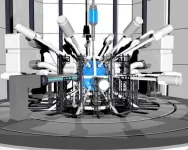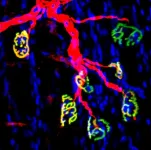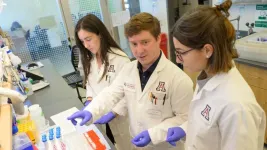(Press-News.org) UNIVERSITY PARK, Pa. — Farmers are used to growing crops and producing other goods, but a new study led by Penn State researchers suggests the social media platform TikTok may help them cultivate something new: empathy around the issue of climate change.
The researchers published their work in the Journal of Rural Studies.
The team, who analyzed responses to climate change TikToks posted by farmers, found that many people responded to the videos with warmth and compassion, signaling emotional empathy.
However, the researchers also found that the videos were not as successful at triggering cognitive empathy in viewers. In this case, the cognitive empathy manifested as comments in which viewers go beyond compassion and engage in thinking critically about the content by adding their own thoughts or asking further questions.
The study suggests that platforms such as TikTok offer new ways for farmers to communicate with consumers, according to Ilkay Unay-Gailhard, a researcher at the Leibniz Institute of Agricultural Development in Transition Economies in Germany who led the study while completing her European Union Marie Sklodowska-Curie Global Fellowship at Penn State.
“Today’s consumers are increasingly looking for transparency in agri-food systems and want to know who their farmer is and how their food is produced,” she said. “They’re also increasingly willing to ensure a sustainable agri-food sector by supporting farmers involved in decisions to mitigate and adapt to climate change. These trends indicate an opportunity for farmers to engage more directly with citizens, as policymakers, media, scientists and activists already have been doing.”
Mark Brennan, professor and UNESCO Chair in Community, Leadership, and Youth Development at Penn State, said the work has the potential to be helpful to farmers and that it’s important to remember that empathy — putting ourselves in the place of others to understand their actions and beliefs — is very different from sympathy.
“When farmers and consumers can better understand each other, we can better foster innovation, increase food security, and enhance the adoption and diffusion of new techniques and markets that benefit all,” Brennan said. “This empathy also shows that farmers and consumers are not that different and want the same things many times. Connecting with them builds understanding and breaks down the artificial divides that are often propagated in our society. We are better together in the end.
According to the researchers, the work was inspired by the dual way that food production both contributes to and is affected by climate change. For example, raising livestock and producing food products can create greenhouse gas emissions that help trap heat close to the surface of the Earth. Simultaneously, these effects of climate change also affect food systems in a variety of ways, including less water or poorer soil quality for livestock and crops.
Unay-Gailhard said this intersection gives farmers a unique perspective, and while conversations about food production and climate change typically happen at the social and political level, the rise of new social media platforms is giving farmers new ways to speak out.
“Today’s young farmers are becoming involved in climate actions in different forms than previous generations,” she said. “Even though farmers are still in the early stages of using social media to initiate conversations about climate change, some social media platforms like TikTok present an opportunity to use new forms of communication with ‘millennial- or Gen-Z-style’ humor to connect with diverse communities on the topic.”
With the goal of better understanding the potential TikTok has for generating empathetic conversations about climate change, the researchers performed a two-step analysis.
First, they analyzed how users engaged with TikTok videos posted by farmers during the 26th United Nations Climate Change Conference, which took place during October and November 2021. It was chosen for the study because it engaged a high number of young environmental activists from across the globe. They ended up with a study sample of 29 TikTok videos that consisted of 2,965 conversations involving 187 accounts from the U.S., the U.K., Canada, Ireland, Australia and New Zealand.
The researchers said that, because of how the TikTok algorithm works to serve content to viewers, they assumed viewers were recommended videos regardless of how they might engage with the content. They analyzed whether the conversations fit into three different levels of empathy, including emotional empathy and two different types of cognitive empathy: interpretational, in which users signaled understanding and interpretation of the viewpoints in the video, and explorational, in which users aimed to further explore or improve their understanding of the video.
In the second step of the study, the researchers interviewed 12 farmers from the U.S., U.K., Canada and Australia who currently use TikTok to better explore their values, attitudes and beliefs surrounding climate change dialogues on the platform.
The researchers found that while many videos were successful in triggering emotional empathy, only a few were able to inspire cognitive empathy. However, they also found that the farmers they interviewed believed that TikTok still has a higher potential for fostering empathetic conversations compared to other social media platforms.
“When we talked to farmers, they believed that creating entertaining content on TikTok resulted in more engagement more quickly than content on YouTube, where it takes longer to reach viewers,” Unay-Gailhard said. “They also felt that presenting themselves and their viewpoints in ‘imperfect’ ways promotes engagement on TikTok, compared to Instagram, where pleasing aesthetics are valued, or X — previously known as Twitter — which is highly polarized.”
The interviewed farmers added that, on TikTok, presenting a straightforward argument with playful and humorous tones allows conversations and even arguments to take place with less tension.
According to the researchers, the findings that TikTok can play a role in engaging audiences in conversations about climate change. Additionally, Unay-Gailhard said the work explores more broadly how empathy is changing in an increasing digital society.
“What is notable from the narratives of TikTok farmers is how empathy among farm-interested viewers turns the platform into a learning landscape,” Unay Gailhard said. “The self-representation of farmers on TikTok with professional identities is not only about having a voice and joy but also reciprocally investing in others in their online community. This reciprocity emerges with gathering and sharing experiences and knowledge within informal educational contexts.”
In the future, the researchers said additional studies could explore how content could go beyond triggering emotional empathy and foster cognitive empathy, as well.
Kati Lawson, University of Florida, also participated in this work.
The Marie Skłodowska-Curie Global Fellowship helped support this research.
END
TikTok may help farmers cultivate empathy around climate change
2023-10-12
ELSE PRESS RELEASES FROM THIS DATE:
Japan’s technology progress pushes laser fusion energy closer to commercialization Ex-Fusion and Tokyo Tech establish collaborative research cluster
2023-10-12
EX-Fusion Inc. (CEO: Kazuki Matsuo, hereinafter referred to as "EX-Fusion") has established a Collaborative Research Cluster focused on advancing liquid metal devices (Terminology 1) for the realization of commercial laser fusion reactors (Figure1, Terminology 2) in collaboration with Tokyo Institute of Technology (President: Kazuya Masu, hereinafter referred to as "Tokyo Tech"). The signing ceremony to formalize this partnership was held on October 11, marking the official commencement of their joint efforts.
The ‘EX-Fusion Liquid Metal Collaborative Research Cluster’ has been established with the support of the Tokyo Tech's Open Innovation Platform. ...
Flooding that closed Alaska's Dalton Highway also caused widespread ground sinking
2023-10-12
The massive 2015 flooding of the Sagavanirktok River in northern Alaska had immediate impacts, including closure of the Dalton Highway for several days, but it also contributed to longer-term ground subsidence in the permafrost-rich region.
That’s the finding by assistant professor Simon Zwieback at the University of Alaska Fairbanks Geophysical Institute in a study published Sept. 27 by the journal Permafrost and Periglacial Processes.
Zwieback is the paper’s lead author. UAF scientists Mikhail Kanevskiy, Donald Walker, Vladimir ...
Private renting is making you age faster
2023-10-12
A new study, jointly conducted by the University of Adelaide and University of Essex, has found that renting, rather than owning, a private-sector home leads to faster biological ageing.
The negative health impacts of renting were shown to be greater than those of experiencing unemployment or being a former smoker.
“Our findings demonstrate that housing circumstances have a significant impact on biological ageing, even more so than other important social determinants, such as unemployment, for example, and therefore health impacts should be an important consideration shaping housing policies,” ...
Inhibiting an enzyme associated with aging could help damaged nerves regrow and restore strength
2023-10-12
Scientists at Stanford University School of Medicine and Sanford Burnham Prebys have demonstrated a new way to accelerate recovery from peripheral nerve injury by targeting an enzyme that was thought to be responsible for muscle wasting with aging.
Damage to the peripheral nervous system (the nerves that form the communications network between the brain, spinal cord and body) is debilitating; the effectiveness of physiotherapy as treatment is limited. Whether from trauma, disease or aging, nerve function declines and/or is lost, resulting in diminished strength and even paralysis.
In ...
New cyber algorithm shuts down malicious robotic attack
2023-10-12
Australian researchers have designed an algorithm that can intercept a man-in-the-middle (MitM) cyberattack on an unmanned military robot and shut it down in seconds.
In an experiment using deep learning neural networks to simulate the behaviour of the human brain, artificial intelligence experts from Charles Sturt University and the University of South Australia (UniSA) trained the robot’s operating system to learn the signature of a MitM eavesdropping cyberattack. This is where attackers ...
A better ‘map’ of the lights you see when you close your eyes can improve ‘bionic eye’ outcomes
2023-10-12
Researchers at Monash University have identified a new way of mapping ‘phosphenes’ – the visual perception of the bright flashes we see when no light is entering the eye – to improve the outcome of surgery for patients receiving a cortical visual prosthesis (‘bionic eye’).
Cortical visual prostheses are devices implanted onto the brain with the aim of restoring sight by directly stimulating the area responsible for vision, the visual cortex, bypassing damage to the retina of ...
Civics test policy fails to increase youth voter turnout, researchers find
2023-10-12
UNIVERSITY PARK, Pa. — A civics test policy mandated in 18 states that focuses on rote memorization and testing of political knowledge did not improve youth voter turnout as intended, according to Penn State College of Education researchers. As an alternative, they recommend a thorough integration of practical information on the voter registration process within social studies curricula.
“Providing students opportunities to really engage with what leadership means, having discussions and debates with leaders and politicians, mock elections… ...
Restoring nerve-muscle connections boosts strength of aging mice, Stanford Medicine study finds
2023-10-12
A small molecule previously shown to enhance strength in injured or old laboratory mice does so by restoring lost connections between nerves and muscle fibers, Stanford Medicine researchers have found.
The molecule blocks the activity of an aging-associated enzyme, or gerozyme, called 15-PGDH that naturally increases in muscles as they age. The study showed that levels of the gerozyme increase in muscles after nerve damage and that it is prevalent in muscle fibers of people with neuromuscular diseases.
The research is the first to show that damaged motor neurons — nerves connecting the spinal cord to muscles — can be induced to regenerate ...
NIA grant supports training of next generation of translational scientists for Alzheimer’s disease therapeutic development
2023-10-12
A prestigious National Institute on Aging training grant to develop a future workforce of research scientists in the field of Alzheimer’s disease and related dementias was awarded to researchers at the Center for Innovation in Brain Science at the University of Arizona Health Sciences.
Roberta Diaz Brinton, PhD, Regents Professor and director of the Center for Innovation in Brain Science, is principal investigator on Translational Research in Alzheimer’s Disease and Related Dementias, or TRADD, a five-year, ...
Birmingham Platelet Group delivers breakthrough ‘nanobody’ technology
2023-10-12
Researchers led by Professor Steve Watson and Dr Eleyna Martin from the Institute of Cardiovascular Sciences at the University of Birmingham have delivered a breakthrough for thrombosis researchers, by producing the first binding molecules (ligands) of defined composition to make platelets clump together in a predictable way.
The research team developed antibody fragments called nanobodies and crosslinked these to make ligands to four platelet receptors (GPVI, CLEC-2, FcɣRIIA and PEAR1).
The nanobodies can be used to develop validated clinical assays for testing patients with platelet disorders such as bleeding or thrombosis, and as research ...



